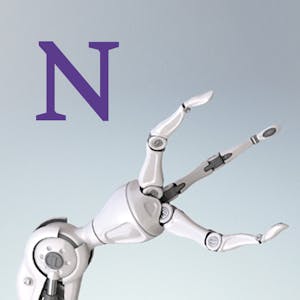Explore the foundational principles of robot motion in the "Modern Robotics: Mechanics, Planning, and Control" specialization. This comprehensive course delves into crucial mathematical modeling techniques applicable to various robotics subfields. Learn about robot configurations, configuration space, degrees of freedom, and spatial velocities, essential for understanding the movement of robots and other dynamic systems.
Throughout the six short modules, you will gain in-depth insights into configuration space topology, representation, and constraints, along with rigid-body motions, twists, and wrenches. The course utilizes the "Modern Robotics: Mechanics, Planning, and Control" textbook and offers hands-on experience with robotics software in Python, Mathematica, or MATLAB, as well as the V-REP robot simulator. Whether aiming for a career in robotics or advanced study, this specialization equips you with the necessary knowledge and skills to succeed in the field.
Certificate Available ✔
Get Started / More Info
The course consists of six modules covering fundamental concepts in robot motion, including configuration space, rigid-body motions, and the use of the CoppeliaSim robot simulator.
Module 1 introduces the "Modern Robotics: Mechanics, Planning, and Control" specialization and provides an overview of the course. It also covers the use of the MR code library, programming language selection, and the CoppeliaSim robot simulator.
Module 2 delves into the concept of configuration space, exploring degrees of freedom, C-space topology, and representation. It also covers configuration and velocity constraints and task space and workspace.
Module 3 continues the exploration of configuration space, focusing on its topology, representation, and constraints. It also addresses topological equivalence related to configuration space.
Module 4 provides an introduction to rigid-body motions, covering rotation matrices, angular velocities, and exponential coordinates of rotation. It also explores other representations of orientation.
Module 5 delves further into rigid-body motions, focusing on homogeneous transformation matrices, twists, exponential coordinates of rigid-body motion, and wrenches. The module also includes a project related to the course.
Autodesk CAD/CAM for Manufacturing offers a comprehensive introduction to computer-aided design and manufacturing using Autodesk Fusion 360 software, empowering...
3D CAD Application course offers comprehensive training in advanced 3D modeling using SketchUp. Perfect for aspiring 3D modelers and engineers.
This course explores age hardening, polymers, and their properties, delving into the use of phase diagrams, strengthening mechanisms, and polymer synthesis methods....
Selective Laser Sintering and Metal Laser Powder Bed Fusion course covers powder bed fusion in polymers and metals. Students learn machine setup, post-processing,...